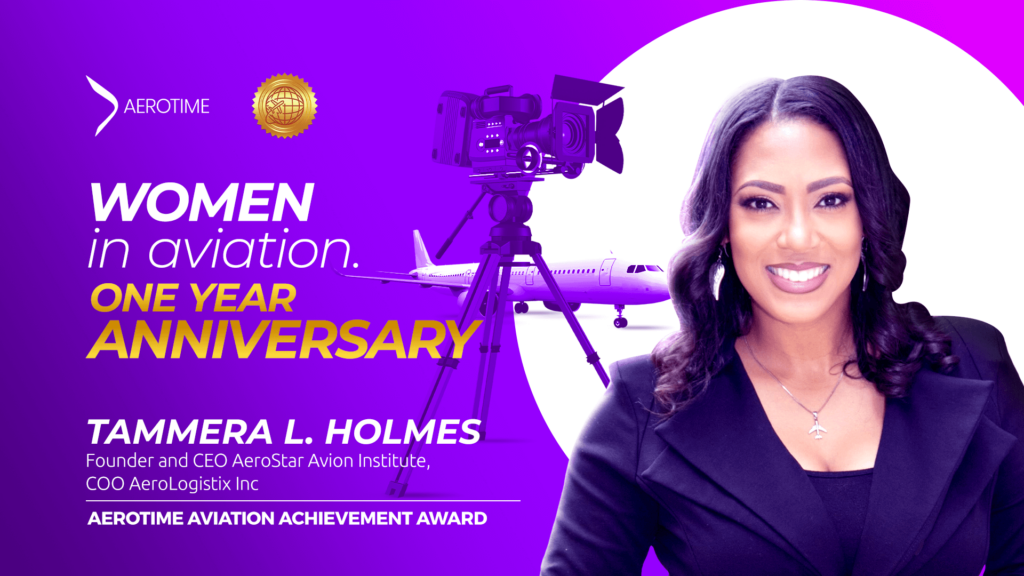Tammera L. Holmes is an obvious choice to receive an AeroTime Aviation Achievement Award. From troubled teenage years, aviation has been her salvation and she has used her own experience to encourage youngsters, especially from minority and under-represented backgrounds, into aviation.
Tammera has an impressive CV. She is Chief Operating Officer and Partner of AeroLogistix, a North American based aviation consultancy, and has been President & CEO of AeroStar Consulting Corporation in Chicago, Illinois since 2008. In 2016, she launched a non-profit organization, The AeroStar Avion Institute, to promote access to jobs in Aviation and Aerospace.
Tammera’s aviation journey began when she was 16 and her mother dragged her to an airport with her brothers and sisters, where free rides in a plane were being offered. In the air, the pilot asked Tammera if she wanted to take the controls.
“I took control of the aircraft, we turned the plane around, and I was flying over Lake Michigan, on the most beautiful day. And I knew then that aviation had not only changed my life, it probably saved my life,” Tammera recounts to AeroTime Editor-at-Large Patrick Jephson in an exclusive interview.
It was a big wake-up call for the young Tammera, who had had a run-in with the police several months prior to the flight and who felt she was in survival mode at high school. Among her classmates, many young men ended up being killed or going to jail.
Now, she works to take children displaying high-risk behavior and offer them options in life that they may never have thought about, in particular using the science behind trauma-based learning.
“I’ve run across these types of kids a lot within my journey in aviation and aerospace education. And one of the things that we do is tap into that,” explains Tammera. “There are so many young people who have what they call a trauma brain, especially in urban communities, and under-resourced communities because of the environment.”
Tammera, who has been diagnosed with ADD and ADHD herself, said the principle is the same as how that flight affected her at 16 years old.
“Unbeknownst to me, I had no clue that I was doing it. All I knew is that aviation worked to cure something in me, that was leading me on the path to distraction.”
Finding yourself in aviation
For Tammera, there’s a wealth of opportunities in the field of aviation, and it’s key to get children involved when they’re young, to make them into aviation professionals from childhood.
“One of the things that we have found was that a lot of young people wanted to get involved in aviation, they just didn’t have access or opportunity from diverse backgrounds.”
Tammera has therefore worked to create pathways for children into aviation, much like there are for youth sports or youth musicians.
The AeroStar Avion Institute focuses on training, educating and employing the next generation of aviation professionals, showing them a wide range of roles.
“Say for example, a young person loves to draw, they love to draw buildings. Why can’t that young person think about becoming an architect or an engineer in aviation? Why do we have to say that aviation is only pilots and mechanics?”, she says. “Our job is to make sure that we focus on the kid and give young people the opportunity to find themselves in aviation.”
Tammera also highlights that just because you start off in one field in aviation, you don’t have to stay there.
“The industry is so forgiving when it comes to being able to move around and take different pathways,” she says. “For me, I started out as a pilot, went into aviation consulting, then went into aviation entrepreneurship, then aviation, aerospace education and philanthropy.”
Future aviation trends
The new generation of aviation professionals will need to be innovative, resilient, persistent and with the insight to solve the future problems of the industry, Tammera says.
Consultancy AeroLogistix is answering the call for aviation to become more robust and innovative.
There’s a long list of projects: “New airports, new space ports, new vehicles, new flight vehicles, new spaceships, Mars colonization, interplanetary travel, air taxis, advanced Air Mobility, customer, infrastructure, customer experience at new airports,” Tammera rattles off. “The work that we do at AeroLogistix is specifically geared and catered towards the future of the industry.”
Airports of the future may involve an airport on one side, a spaceport with a launchpad on the other, plus areas for electric vehicles and aircraft, Tammera predicts. “We are really in uncharted territory.”
Supersonic travel is also on the cards, once again, Tammer believes, predicting it will happen in the next five years on the American continent.
But, what’s next for this inspiring woman?
Although she has no desire to become a pilot, Tammera, who has 100 hours of flight time under her belt, says the sky is calling and she has an itch to finally get her pilot license.
“As far as career aspirations in aviation, I will grow AeroLogistix to a multi-million dollar aviation consultancy,” Tammera says. “And we will grow the AeroStar Avion Institute into an international organization serving youth and young adults in aviation and aerospace education across the globe.”


